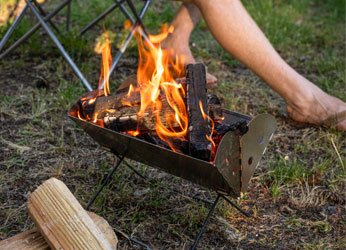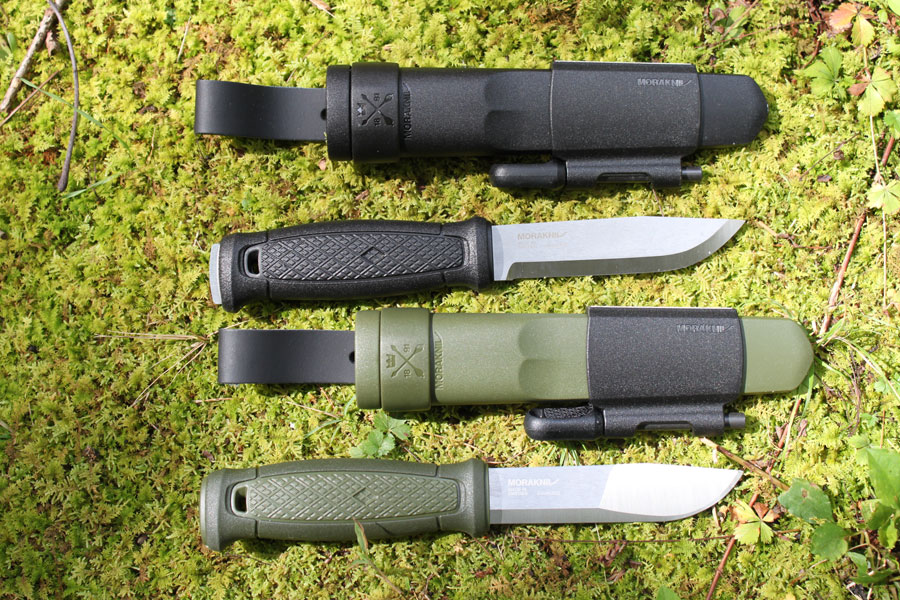
Fire Starting Skills for Campers and Survivalists
by Jim Dickson

Fire Is A Tool
A fire is a basic tool of both comfort and survival yet many people are frustrated in their attempts to build one by their impatience to use wood that is too large at the beginning. Just like most things in life you have to start small and grow. With a fire that means starting with tinder if you are using a flint and steel or dry grass, leaves, pine needles, and twigs if you have a match.
Increase Tinder Size Slowly
The whole idea is to get a flame started and then add more little twigs going up in size as the flame grows until you get sticks or logs the size that you want burning. Do not build too large of a fire unless you have plenty of firewood laid up at the ready as big fires consume a lot of wood fast. The Native Americans and frontiersmen did not go in for big fires as a rule.
Always clear off the ground before building your fire there. Snow will extinguish the flames and leaf litter will spread the fire and burn your camp down and everything else around it.

Some people think there is only one way to layout the wood on a fire. If that was true we would not need any fire departments. You can arrange the sticks like a teepee, lay them haphazardly, put two big logs on each side and build a small fire between them and then lay sticks across the two big logs. It all burns.
Make a Hidden Fire
If you want a fire that will not draw unwanted attention dig a fire pit for your fire 2 to 3 feet deep and 1 & ½ feet wide with straight, vertical sides Then dig another hole beside it one foot away and a foot and a half deep. Dig a short tunnel big enough for your arm to go through to connect them at their bases with solid earth between them the rest of the way up. This will allow a draft to keep the flame going. A small fire in this fire pit will put out a lot of heat channeled straight up without having to have flames and light visible from the sides. When finished, you can fill the dirt back in and cover the surface like no one was ever there.

Cooking Over A Fire
While a cooking grate is handy you can do without one just as easily. Betty and I would put our cooking pots and coffee pot right up next to the fire where the water would boil just fine. Fish and game can be skewered on a stick and held over the fire like roasting marshmallows. Cut big sections of meat into steak strips for faster cooking. This is my method for cooking all wild game and fish in the field. I wouldn’t call it Native American style though. The Cree Native Americans I know are all gourmet cooks and their methods of preparing beaver involve more condiments than I will ever have plus hours of slow cooking in an oven. I am not a gourmet and when I want to eat I want to eat right now, not hours from now.

The Flatpack portable grill & firepit packs compact for easy transportation to the beach, campsite, or barbeque. It’s constructed of stainless steel for durability and easy maintenance. After a quick 30 second set-up, you’re ready to go. $49.99

If you want to use a frying pan just set up some rocks that it can rest its edges on and build a small fire under it or make a bigger fire and let it burn down to hot coals. Add small wood as needed.
If you want a cooking grate they can either be big welded up semi-permanent affairs or just the small grate from a barbecue grill or a toaster oven positioned on stones above the fire like the frying pan was.
Making An Quick Fire

This UCO fire-starting kit includes 3 ways to easily start a fire, no matter the weather. Keep it in your vehicle for any situation $19.95
When Betty and I knew we would be returning to our camp late and be in a hurry to fix supper and get to sleep I would take wax fire logs and cut them in two with an axe while they were still in the wrapper. I would then put a small paper bag over that open-end and tape it down all the way around the bag with masking tape as it would be dropping fragments otherwise. Instant fire and you can add on big wood at the beginning if you like now.

Campfires In The Rain
Rain is the bane of campfires but we always stretched a tarp over our camp site so we would have a place to cook out of the rain. Just tie the cotton cord to the corners of the tarp and then tie this to the surrounding trees making sure that one end is higher than the other so that it doesn’t catch water and fill up. The tarp should also cover the entrance to your tent. It should be high enough for you to comfortably stand up under.
Finding Dry Wood In The Rain
You can gather all the firewood you need from the forest floor but when it is raining you need to look for standing dead wood or cedar. Even if the outside of the wood is soaked the inside will be dry and you can get to that with an axe. Of course, you should always have gathered a stock of firewood and stashed it under your tarp before the rain but that doesn’t always work out in practice. You may not have a chance or that stack may run out before the rain does.

Cutting Wood
When it comes to cutting wood a full size axe is so far superior to any hatchet or tomahawk or Hudson’s Bay axe, that it is well worth carrying. Do not chop wood where your axe blade may go on into the ground. Rocks and dirt will destroy your edge in no uncertain terms. A hatchet or tomahawk is still very useful for cutting and splitting small wood. A two man crosscut saw or a one man crosscut saw can cut as good as a chainsaw in expert hands.
A bowsaw is also useful. Saw teeth on the back of a knife are a bad joke played on you by a con man salesman though. A machete will also cut wood fast and efficiently while weighing next to nothing on your pack. Just don’t try to twist it to bust a chip out like you would with an axe. It’s thin blade wasn’t made for that. The thicker blade of the Philippine bolo knife and the Gurkha kukri enable them to take out chips better and they can work better than a hatchet on wood.

U.S. Army issue M1909 Bolo Knife with edge reground so it will take a sharper edge, and Gurkha Kukri.


